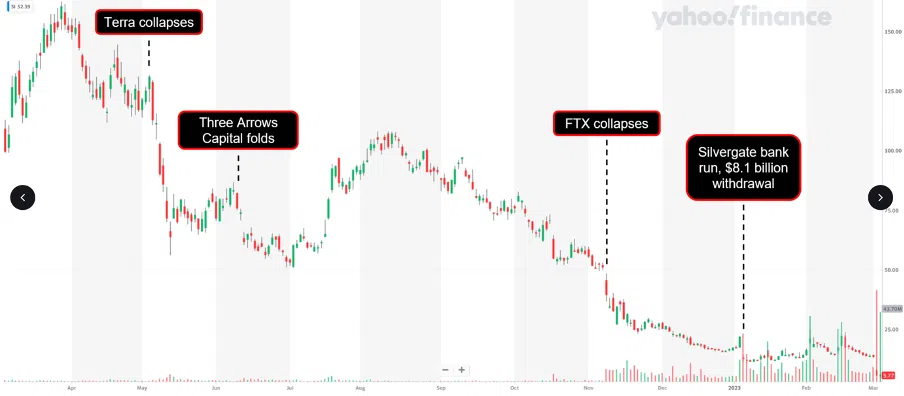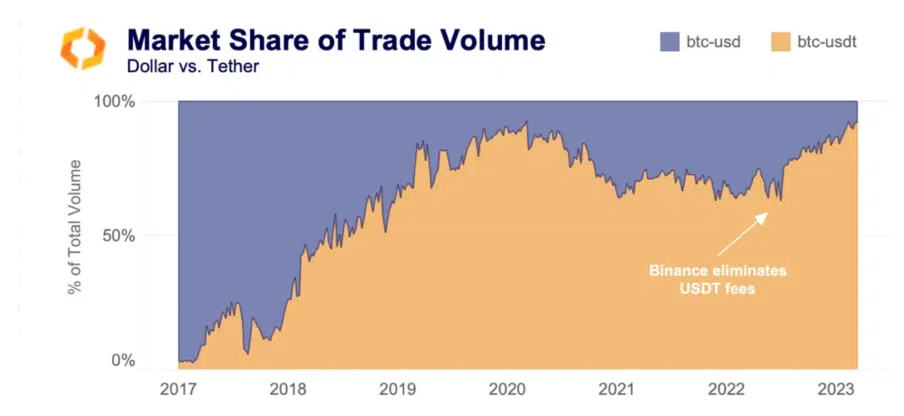Stablecoin volume is rising as the latest crypto bank fallout – Silvergate – continues to worsen.
Silvergate, the crypto-friendly bank, is facing a customer EXODUS and a steep decline in share price as the bank stares down the barrel of insolvency.
Silvergate is Facing Selling Pressure
One of the most prominent banks in the crypto industry, Silvergate earned a reputation for attracting customers holding digital assets. The California-based institution offers a range of services tailored to the needs of crypto businesses, including funding, wire transfers, and custody solutions.
The bank has been a pioneer in cryptocurrencies and one of the first to recognize the potential, offering specialized banking services to the industry.

Today considered a digital assets specialist, Silvergate’s majority deposits originated from traditional banking customers. The bank pivoted in the past decade from a small regional presence into a central bank with $12B in deposits by Q3 2022. Silvergate enjoys a client list of major crypto institutions like Coinbase, Gemini, FTX, and BlockFi.
However, the institution took a blow following its involvement with the bankrupt exchange FTX. As the crypto contagion spread, the bank repercussions, even regulators’ radar.
Silvergate potentially going bankrupt, pushing prices down a bit more.
On the other hand; people piling into positions since the news and no real movement on #Bitcoin
This might be an assumption people are heavily skewed to the short side here.
Time for a squeeze.
— Michael van de Poppe (@CryptoMichNL) March 2, 2023
Old-Fashioned Bank Run
Meanwhile, since news broke of Silvergate’s missed SEC report filing, its share price has halved in value. Asserting that it would be delaying the filing of its annual report.

The news adds growing concerns Silvergate Bank may be in the death throes of insolvency following an $8 billion drawdown. Silvergate’s major crypto clients have suspended business with the institution.
Clients include Coinbase, Circle, Paxos, Crypto.com, Bitstamp, Cboe Digital Markets, Galaxy, and Gemini. Following the exodus, the second most shorted stock now trades below $6.
Indeed, this has raised numerous questions and doubts on social media platforms. There’s an increased censure about crypto’s resilience on centralized financial entities. The small handful of crypto banks — specifically Silvergate (and Signature) — represent convenient chokepoints and easy targets for anti-crypto regulators to undermine the industry.
The team at Bankless shared a quote regarding the brewing situation that read:
“A TradFi blowup oughtto push regulators to establish clearer guidelines and protections for good faith actors aiming to innovate, but in all likelihood, the federal government will just use this as another excuse to put up roadblocks for institutional players that embrace crypto.”
Investors jump off the ship for a cash alternative as the situation unfolds.
Moody’s Downgrade Silvergate
Silvergate Capital puffed out its Exchange Network (SEN) in a “risk-based” decision following a deposit rating downgrade from Moody’s. The Exchange Network (SEN) serves as a critical on-ramp for US crypto investors to transfer between crypto firms.
Are Stablecoins the Answer?
With SEN’s demise, will stablecoins become more essential for traders? Ergo relies on digital assets as a replacement for traditional finance. This could explain the increase in activities around stablecoins. Volume around stablecoins continues to reach new heights.
shows the dollar-to- trade volume market share (for BTC trading pairs) climbed from 3% to 92%.

The team at the market research firm stated:
“With the death of SEN, stablecoins will likely become even more ubiquitous among traders. Rather than deposit your dollars with an exchange, you deposit them with a stablecoin issuer, receive stablecoins, and then transfer those to an exchange.”
Racing Towards Quality and Transparency
Such instances provide a deep dive into trustworthy entities within the crypto market.
Such as stablecoins – digital assets created to maintain a stable value often pegged to fiat currencies such as the U.S. dollar. Consequently, they are considered as instruments against inflation for several reasons:
- Stability: Stablecoins are designed to maintain a stable value, which makes them less susceptible to fluctuations in the market compared to other cryptocurrencies. This stability helps to protect against inflation, as the value of the stablecoin remains relatively constant.
- Accessibility: Stablecoins are often easily accessible to anyone with an internet connection, making them a convenient tool for anyone looking to protect their assets from inflation.
- Liquidity: Stablecoins are often highly liquid and easily converted into other assets or fiat currency. This liquidity makes it easy to use stablecoins as a store of value, as they can be easily converted back into traditional currency when needed.
- Transparency: Many stablecoins are built on blockchain technology, providing high transparency and accountability. This transparency helps to build trust in the stability of the stablecoin and can provide investors with greater confidence in their investment.
Are Stablecoins Commodities or Currency?
Like gold, the definition of a stablecoin often interchanges, depending on the end-use case. For example, stablecoins can be seen as a currency when used as a medium of exchange to pay for goods and services.
Conversely, if a stablecoin is being used as a store of value or for speculative investment, it’s often playing a role as a commodity. In such cases, people may buy stablecoins as a hedge against inflation or market volatility. Holders of stablecoins often try to profit from price fluctuations like foreign exchange arbitrage.
Regulators have locked horns with crypto innovation and will continue if the abovementioned instances unwrap. Yet today, history has shown complete trust in centralized exchanges can further exploit the system. It’s why diversification is critical. Meanwhile, regulatory ambiguity still exists in stablecoins



 BlocksInform
BlocksInform










